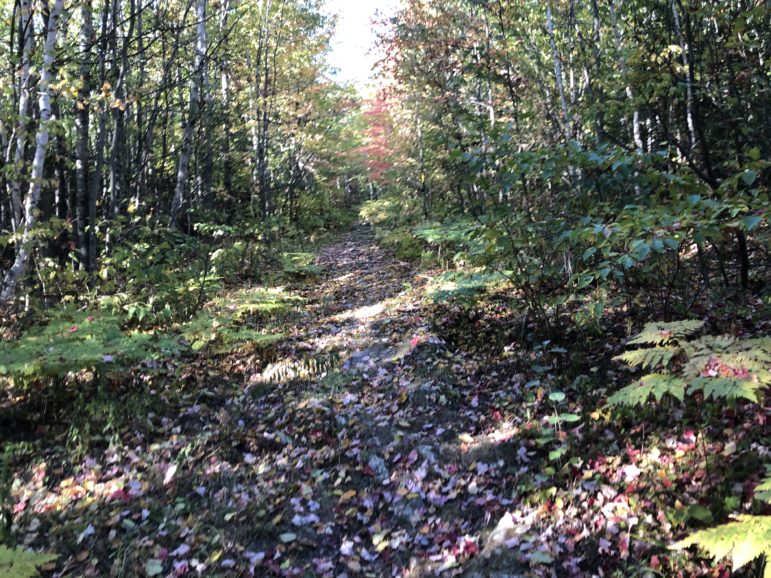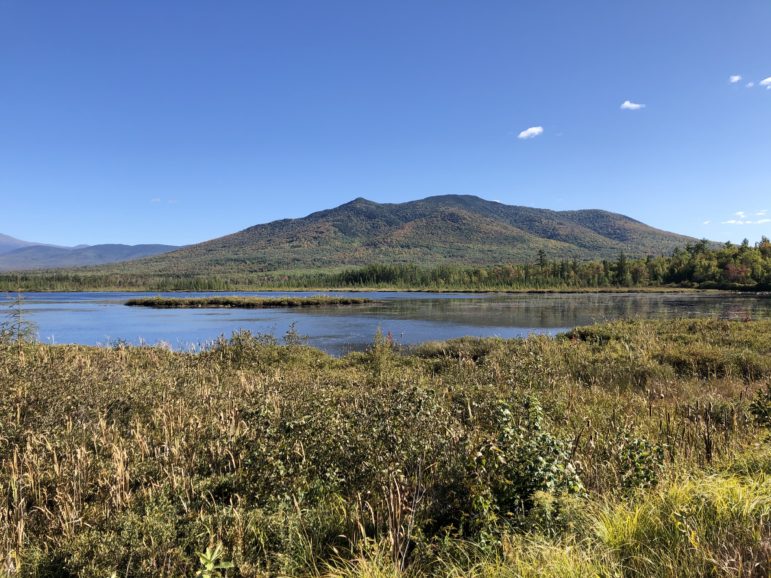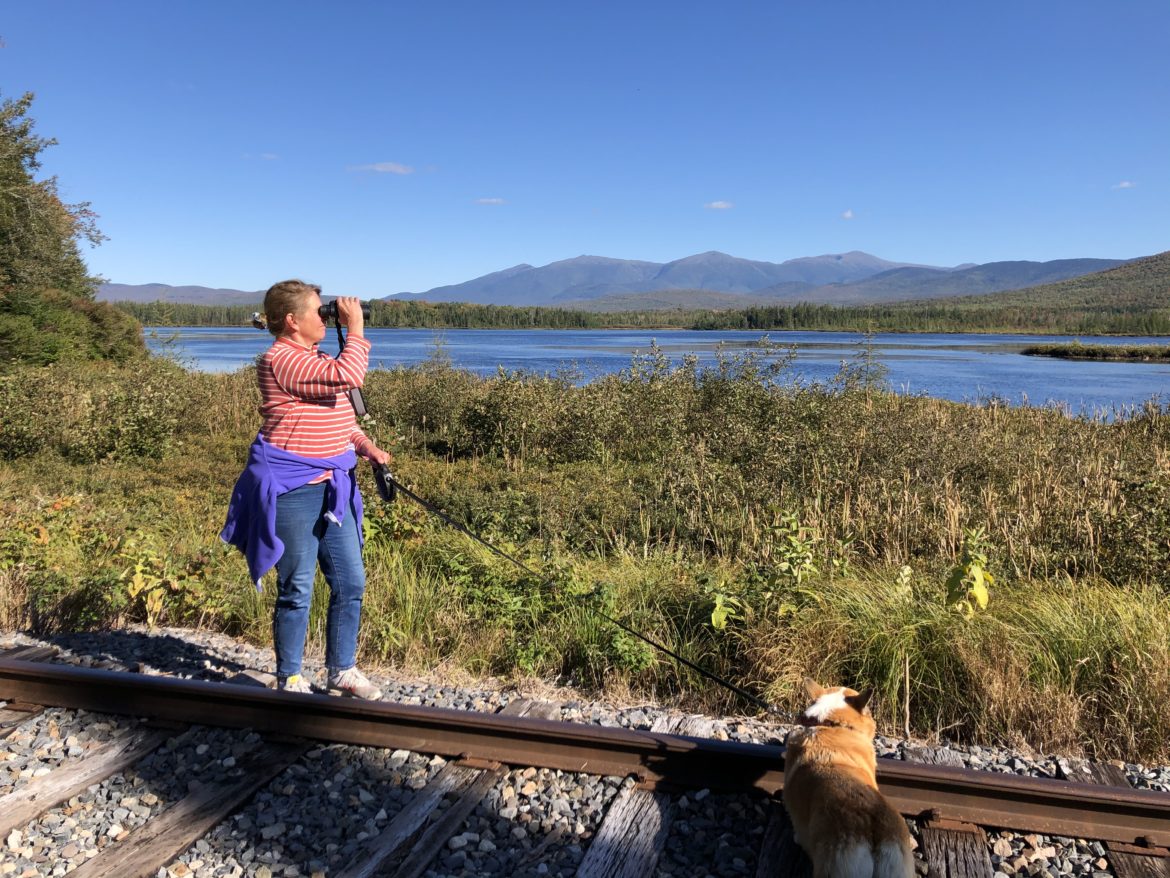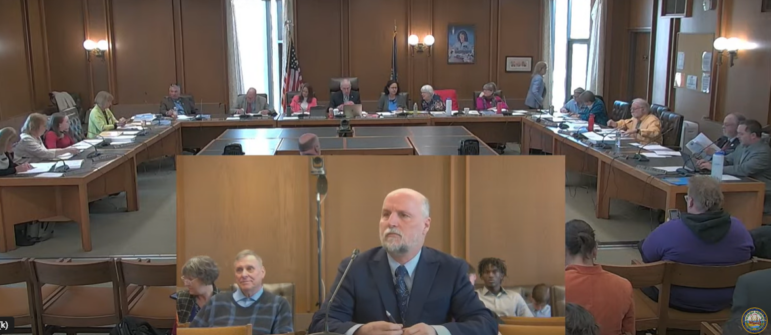
By PAULA TRACY, InDepthNH.org
Some call it the “crown jewel” of New Hampshire’s landscapes and a national landmark because of its diversity of habitat and wetlands.
The Pondicherry National Wildlife Refuge is perhaps the best kept little secret with the most stunning view of the White Mountains I have ever seen across a body of water.
Tucked away from civilization is this massive, 10-square mile nature preserve in Jefferson, Whitefield, and Carroll. Its centerpiece is a 100-acre natural and wild Cherry Pond with a staggering view of Mount Washington and the Presidential range rising up only 12 miles away.
This fall, it is my pick for a wonderful walk in what will likely be a socially distanced foliage season.
You won’t be bothering the neighbors here because there are none.
In 1972 it was designated a national landmark by the National Park Service and named the first important bird area in New Hampshire in 2004.
In fact, more than 238 species of birds have been identified here, including over 50 species of water birds.
Habitats are also diverse and include open water, boreal forests, swamps, early successional habitat, grasslands, some champion aged trees, fens, floating peat bogs, and northern hardwoods.
I saw moose tracks in the mud, coyote scat on logs, was startled by ruffed grouse, saw a large Common loon and only a handful of human beings in a three-hour visit.
It was peaceful.
I made the trek on Sunday by foot with my dog, binoculars, and cell phone which was useless save for its camera.
You can see by these photos from my iPhone, which doesn’t do it justice, that this is perhaps the most perfect view of the White Mountains to visit this fall without venturing on a long and arduous hike or dealing with crowded overlooks.

There are no camps on Cherry Pond. No roads. No human sounds out here. Only birds and a possible passing airplane.
To get in, one only needs to walk in some cases several miles over flat, sometimes bog-like terrain.
There are many types of trails, as I will get to, but I only ventured on to one.
By chance, I took the most remote and longest of the trails in. It is the Col. Whipple Trail off Whipple Road in Jefferson. It took about an hour to get to the lake over the flat and sometimes rocky, boggy, uneven and narrow trail.
The foliage to the north had begun to show some reds and orange and the view of Mount Washington and the Northern Presidentials was clear out across the pond, which is only about six feet deep.
In another two weeks, this area will likely experience peak foliage at the end of the migratory season.
My introduction began in the 1970s.
I knew about Pondicherry almost 50 years ago but it seemed far, remote, and inaccessible to me then as a child growing up in Concord.
I used to take art classes for kids at the Currier Art Gallery in Manchester. My teacher was Mrs. Barbara Day Richards, and we became friends.
I was not a good artist, but I loved nature and flowers and she did as well and we had the mutual experience of living in Oxford, England. I had just returned after a year of living on Boar’s Hill.
She was the wife of Tudor Richards, who is known to this day as the “father of Pondicherry.”
Richards began his career in New Hampshire at Fish and Game, focusing on birds, and later became the leader of the Audubon Society of New Hampshire.
In the summers, while he was at Audubon, I was invited to their home in Hopkinton to participate in puppet productions. All the characters were made by the Richards family and friends. It was called the Small World Theater.
I began then to learn about this mysterious place, Pondicherry. And while I spent some summers growing up on Lake Christine, near the Percy Peaks near Stark and my parents both loved birding, we never made it to Jefferson to see the pond.
I think in their retirement years before the death of the Richards, my parents did make it to see Pondicherry.
Beginning in the 1940s, Tudor Richards had ventured to Jefferson to the area noted by the ornithologist Horace Wright who began in 1899 to research his book “The Birds of the Jefferson Region in the White Mountains.”
Wright found a treasure trove of birds – many of them rare – that flocked here to nest, fledge their young and stop for rest while migrating south in the fall.
Richards would spend long periods of time at Cherry Pond and Little Cherry Pond watching the birds from the migratory season, which is now underway, to spring breeding.
Richards grew a deep love for this place and it is he who convinced all state, federal and local conservationists to preserve it to what it is today: a 6,405-acre national wildlife preserve rich with bird and wildlife.
It is now a division of the Silvio O. Conte National Wildlife Refuge program which is operated by the U.S. Fish and Wildlife Service. It is preserved in partnership with the Audubon Society of New Hampshire and the New Hampshire Fish and Game Department.

Richards got the first 312 acres preserved by Audubon in 1963 from the Brown Paper Company. In 2000, the U.S. Fish and Wildlife Service acquired an adjacent 670-acre tract using duck stamp proceeds.
Conte, who represented Massachusetts in Congress for 32 years, was an avid environmentalist. He began an effort, which now bears his name, to protect vital habitat along the Connecticut River watershed from its source to the sea and this refuge was established as part of that massive effort.
The land is part of that Connecticut River watershed and includes the Johns River which runs through it and is near the Israel River, which both flow into the Connecticut River.
The Friends of Pondicherry National Wildlife Refuge have served locally to help protect and keep up this amazing place, a haven for all its creatures and varied habitat.
The Ammonoosuc Chapter of the New Hampshire Audubon Society has also played an important role as has David Govatski, a long-time local birder and environmentalist who has written an exquisite piece on the property, which is linked here: https://fc1d92f1-640b-4e18-93fc-8e5866efe765.filesusr.com/ugd/8ad160_a68d45e54dcd42d68469f3d1581cd0f3.pdf
Tudor Richards was the one to dub the place “Pondicherry” after seeing the name on a map by early French explorers.
My Visit
My normal Zoom church service in my dining room Sunday got me thinking about the beauty of the earth. I looked outside on the day before me with nothing particular to do.
Rather than processing pounds of tomatoes from my garden into sauce, which I could do at night, my thoughts for some reason went to Tudor Richards and then, of course, my long-held desire to see this place called Pondicherry.
Instead of researching how to get into Pondicherry before I went as I usually do, I made the decision to drive up to Jefferson and explore from the ground and see where I got.
I did a few things wrong.
I did not bring water to drink, a bird book, and I did not know how long the trek to the pond would take.
There are a number of trails into Pondicherry mostly to its north and west.
The first I found was the Colonel Whipple Trail which is part of the long Coho Trail across the Great North Woods.
It is found off the dirt Whipple Road in Jefferson.
There is a small yellow gate and room for about four cars in the lot and very little information on how long the trail is or what to expect.
The trail is about 2 to 2.5 miles long and named for Col. Joseph Whipple, founder of Jefferson and a leader of European settlers in the region.
I found later that there is a shorter way in and handicapped accessible, but it is under construction right now.
It is called the Pondicherry Trail, 1.6 miles which is found off Airport Road in Whitefield. It leads to an observation platform named in honor of Tudor Richards.
By the end of September, the trail will have a new ledge pack and improved access for the handicapped, bicycles and baby strollers.
There is also the Mud Pond Trail, a .6 mile walk off Route 116 in Jefferson, and the 1-mile Little Cherry Pond Trail into the 20-acre pond, which connects to the larger Cherry Pond.

There are other trails as well. The Col. Whipple Trail is a narrow swath that begins through an early successional forest which was cut in 1998 before it was conserved and then leads into an older forest, then into a boggy sort of area with dried peat moss and split logs covered in rusting chicken wire to prevent slippage when wet.
Follow the yellow blazes. The drought is noticeable here as there was no water for my dog, Maisy, to drink until we got to the pond.
About a mile and a half in, we came to an opening, really a blowdown area where you could catch a glimpse of Cherry Mountain, its pointy narrow summit unmistakable, like a Hershey’s kiss a few miles away.
The early part of the trail had lots of wild purple aster and goldenrod in bloom and the woodland area, a boreal forest, had plenty of wild wintergreen and wildflowers.
The boggy part of the trail apparently has some carnivorous plants like sundews and pitcher plants, which trap bugs that become food. I did not see any.
While the footing was a bit rocky in places, I imagine this to be an excellent spot for winter snowshoeing or perhaps a backcountry ski.
I was a bit spooked by the sound of ruffed grouse taking off in the woods and heard the sweet sounds of birds I could not recognize as I drew closer to the pond.
The pond is amazingly rich with birds.
There are currently a total of 122 breeding species on the preserve with the warblers breeding here in May and June and the migratory waterfowl season from September to October.
Considered “specialty” species of the Pondicherry are the Common loon, which I saw near a large floating bog, the American Black duck, the Ring-Necked Duck, Ruffed grouse, the Northern harrier, American woodcock, Wilson’s snipe, the whip-poor-will (a nightjar), the black-backed woodpecker, marsh wren, chestnut-sided warbler, palm warbler, and the Canada warbler. A list can be found on the Friends of Pondicherry website.
It is so far north that one can also possibly see a Canada Jay or “whiskey Jack” and sometimes a visiting snowy owl.
When the Col. Whipple trail ended, there were signs that I was entering the refuge and got on to a trail of the same yellow blazes called “Ice Ramparts.”
The trail seemed to turn from the south to the west as the trail opened up to see the great pond and its amazing mountainous backdrop.
The trail overlooks the grassy area that leads to the water and my dog, who I keep on a leash at all times for fear of her being spooked and lost to the wilderness, was desperate to get down for a drink and a swim.
We kept on the trail, passed a little overlook bench, and came to a spot where she could get down into the water and its sandy soil to swim and drink.
The water is low due to the drought and though shallow, it was once 48 feet deep and much larger in another era, which you can read about on the friends’ website.
It was an ancient glacial lake 11,800 years ago where Paleoindian hunters found migrating caribou.
Keeping along that trail, we eventually came to railroad tracks where we encountered three people with binoculars and foreign accents willing to take our picture.
They appeared to have come in from another direction.
I read when I returned home that this area is known as Waumbeck, an old intersection of rails where there was once a passenger station, freight house, and station agent’s home in the early 1900s.
The rail crossing from roughly north to south was that of the Maine Central Railroad and from east to west, the Boston and Maine Railroad line.
The tracks to the north are still active so those walking in on the tracks from Route 116 to the pond should be aware of an occasional train.
Dusk is early now and I wanted to get out of the woods before dark so I did not linger as long as I would have liked along the water’s edge, but will on my next walk in.
I enjoyed having my binoculars to look closely at the shoreline, at Mounts Adams and Jefferson, and of course, the highest peak in the Northeast, Mount Washington, with its busy buildings on the summit and visible trails.
The walk out was lovely but it seemed for some reason longer than the walk in.
It was a wonderful afternoon in the quiet, beautiful woods of New Hampshire.
I felt thankful for Tudor Richards and his stewardship which endures and provides a place to rest and nest for so many of his winged friends.
It is Tudor’s living legacy.
Here are some links to help you prepare for a visit.
To get up to date information I suggest the Ammonoosuc Chapter of the NH Audubon here https://www.facebook.com/ammonha1
These are the sources I used to build this column:
https://www.friendsofpondicherry.org/
http://www.nhaudubon.org/pondicherry-wildlife-refuge/
https://www.fws.gov/refuge/Silvio_O_Conte/about/nh.html
https://www.nh.gov/nhdfl/documents/pondicherry4.pdf
https://www.facebook.com/pages/Pondicherry%20Wildlife%20Refuge/118217731562556/





